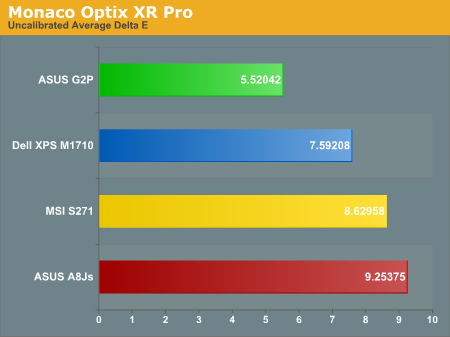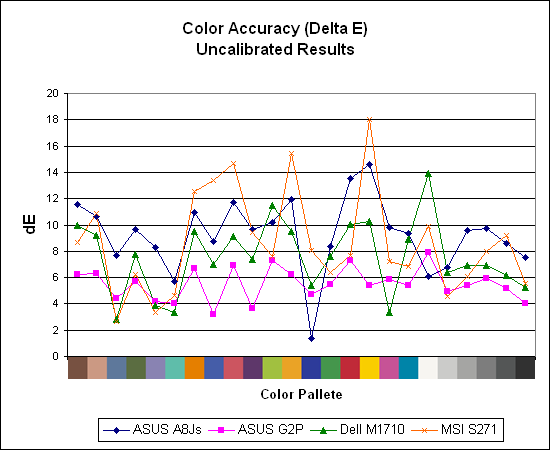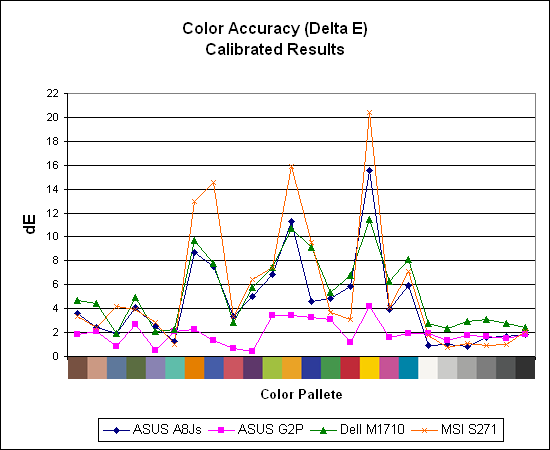Laptop LCD Roundup: Road Warriors Deserve Better
by Jarred Walton on May 22, 2007 5:00 AM EST- Posted in
- Displays
Color Accuracy
Other than adjusting the brightness level, there's not much that can be done with a laptop to change the default color values. The vast majority of users almost certainly use no color profile, so our uncalibrated color accuracy charts will be the most meaningful for them. Some people require more accurate colors, however, and while our instinct says that none of these displays can match the quality of the desktop LCD - even the best of them seems noticeably inferior to any of the desktop LCDs we've reviewed - the only way to prove or disprove this opinion is through actual objective testing.
During testing, Monaco Optix XR Pro sends 24 color patches to the display with the colorimeter measuring the resulting values. The difference between what is requested and what the LCD actually shows is known as Delta E, with lower values being better. Any score less than one is basically "perfect" - the naked eye is not going to be able to tell the difference - and scores less than 2.0 are very nearly perfect. Ideally, for accurate colors you would want all of the tested colors to have a Delta E of less than 1.0, but almost no one is likely to have problems with anything scoring below 2.0. From 2.0 to 4.0, most people still won't notice the slight inaccuracies in the color palette, but when comparing displays side by side differences may be apparent; multimedia professionals would prefer something better. Anything above 4.0 begins to represent a more significant deviance, and numerous scores above 6.0 will almost certainly be noticeable by just about anyone. Beware also of spikes in the Delta E charts, as a low average Delta E with several high spikes may not be as good in actual use as a display that offers a higher average Delta E but without the spikes.
Uncalibrated Results


Without any form of color correction, the color accuracy of all of these displays is poor. The ASUS G2P clearly generates the best overall score with a Delta E result of 5.52. However, there are still plenty of colors that fall above the 6.0 threshold, and even one that hits 8.0. As bad as that might seem, the other three displays are clearly worse. The XPS M1710 places second by a reasonable margin, but with several colors showing a Delta E of over 10.0 it's certainly nothing special. The MSI and ASUS A8Js both exhibit extremely poor color accuracy, with multiple large spikes on certain colors. We've seen some relatively poor uncalibrated results on desktop displays that have been turned around after calibration, so let's see if that's the case here.
Calibrated Results


If you were hoping for a turnaround after calibration, the above charts are probably pretty disappointing. As we've mentioned several times already, the ASUS G2P is far and away the best LCD out of the laptops we've used, and the calibrated color results bear this fact out. By no means are the results perfect, but with an average Delta E of 1.95 it at least comes relatively close, and only one color actually falls above the 4.0 threshold.
The other three laptops all get lower average Delta E scores after calibration, but they all have very similar curves with certain colors that simply cannot be accurately displayed. Yellows and blues in particular seem to present problems for many laptops, and there are a few colors that actually got worse after calibration! The backlighting used on a display can have a very large impact on the color accuracy, and we would venture to guess that most laptops are using similar low-power lamps that don't cover a lot of the standard NTSC color gamut. For anyone that's serious about doing image editing work on a laptop, consider this a warning that you will want to get a separate desktop LCD if possible in order to get a better representation of colors.
Other than adjusting the brightness level, there's not much that can be done with a laptop to change the default color values. The vast majority of users almost certainly use no color profile, so our uncalibrated color accuracy charts will be the most meaningful for them. Some people require more accurate colors, however, and while our instinct says that none of these displays can match the quality of the desktop LCD - even the best of them seems noticeably inferior to any of the desktop LCDs we've reviewed - the only way to prove or disprove this opinion is through actual objective testing.
During testing, Monaco Optix XR Pro sends 24 color patches to the display with the colorimeter measuring the resulting values. The difference between what is requested and what the LCD actually shows is known as Delta E, with lower values being better. Any score less than one is basically "perfect" - the naked eye is not going to be able to tell the difference - and scores less than 2.0 are very nearly perfect. Ideally, for accurate colors you would want all of the tested colors to have a Delta E of less than 1.0, but almost no one is likely to have problems with anything scoring below 2.0. From 2.0 to 4.0, most people still won't notice the slight inaccuracies in the color palette, but when comparing displays side by side differences may be apparent; multimedia professionals would prefer something better. Anything above 4.0 begins to represent a more significant deviance, and numerous scores above 6.0 will almost certainly be noticeable by just about anyone. Beware also of spikes in the Delta E charts, as a low average Delta E with several high spikes may not be as good in actual use as a display that offers a higher average Delta E but without the spikes.
Uncalibrated Results


Without any form of color correction, the color accuracy of all of these displays is poor. The ASUS G2P clearly generates the best overall score with a Delta E result of 5.52. However, there are still plenty of colors that fall above the 6.0 threshold, and even one that hits 8.0. As bad as that might seem, the other three displays are clearly worse. The XPS M1710 places second by a reasonable margin, but with several colors showing a Delta E of over 10.0 it's certainly nothing special. The MSI and ASUS A8Js both exhibit extremely poor color accuracy, with multiple large spikes on certain colors. We've seen some relatively poor uncalibrated results on desktop displays that have been turned around after calibration, so let's see if that's the case here.
Calibrated Results


If you were hoping for a turnaround after calibration, the above charts are probably pretty disappointing. As we've mentioned several times already, the ASUS G2P is far and away the best LCD out of the laptops we've used, and the calibrated color results bear this fact out. By no means are the results perfect, but with an average Delta E of 1.95 it at least comes relatively close, and only one color actually falls above the 4.0 threshold.
The other three laptops all get lower average Delta E scores after calibration, but they all have very similar curves with certain colors that simply cannot be accurately displayed. Yellows and blues in particular seem to present problems for many laptops, and there are a few colors that actually got worse after calibration! The backlighting used on a display can have a very large impact on the color accuracy, and we would venture to guess that most laptops are using similar low-power lamps that don't cover a lot of the standard NTSC color gamut. For anyone that's serious about doing image editing work on a laptop, consider this a warning that you will want to get a separate desktop LCD if possible in order to get a better representation of colors.










55 Comments
View All Comments
strikeback03 - Tuesday, May 22, 2007 - link
The first page mentions that you don't know of any laptops which use an LCD that isn't a TN panel. The Flexview Thinkpads use IPS panels, and they are nice. Any chance of getting one of those in the comparison?n7 - Wednesday, May 23, 2007 - link
And Macbook Pros use IPS.Sadly, i'd say 99% of notebooks have garbage for displays.
Only good thing to come from notebook displays is glossy finishes, as now that's finally spreading nicely into the desktop segment.
bldckstark - Wednesday, May 23, 2007 - link
Apple is currently being sued for poor display quality. Word is they are using TN panels in both Pro and regular versions. I guess we will find out more soon, since this is another high profile (if unwarranted) case against Apple.n7 - Wednesday, May 23, 2007 - link
They aren't using TNs in the Macbook Pros, at least not all the ones i've seen.In the regular Macbooks, yes, they use TNs, like everyone else.
strikeback03 - Wednesday, May 23, 2007 - link
Personally I hate glossy finishes, thankfully neither my laptop or desktop have one.I thought I had read somewhere that some Macbooks used IPS as well. They are certainly popular amongst traveling photographers.
drwho9437 - Tuesday, May 22, 2007 - link
While Flexview is IPS, it is not offered at the moment (CTO though perhaps in prebuilt T60 models still).It is unknown if Lenovo will bring it back, but it was one of the few panels out there that had good color by most accounts. There were objective measurements done at the Thinkpads.com forum once upon a time...
I myself didn't get flexview due to the size and cost. I'm quite happy with my T60, but i a 14" wide or standard IPS display is marketed in a Lenovo package, I will certainly be tempted. I don't think I can go back to 'regular' laptops after using my Thinkpad.
Pirks - Tuesday, May 22, 2007 - link
ditto here, I saw IPS screen on a Thinkpad and it was gorgeous compared to other shitty apple and dell notebooks I saw. so I was seriously surprised to find out that Anand guys don't know about it. guys, your credibility has plummeted down in my eyes. to not know anything about IPS displays in Thinkpads - what kind of techies are you anyway? sheesh... overclocking, overclocking... blah blah... while not knowing about such an OBVIOUS thing as IPS based Thinkpad... sigh :-(DigitalFreak - Tuesday, May 22, 2007 - link
Dude, STFU.JarredWalton - Tuesday, May 22, 2007 - link
Not everyone knows everything about every computer part. I'm glad someone makes a laptop with a non-TN panel, and I have updated the article text. As it said, we were "as yet unaware" of such laptops, and we are now aware. Hopefully Lenovo will be good enough to get us a unit for testing. The point stands that only one manufacturer so far (I think?) makes such a laptop, no one makes a major point about advertising the laptop panel specs or type, and as far as I can tell it's only in the 12.1" X series. We definitely need more such notebooks.strikeback03 - Wednesday, May 23, 2007 - link
Suppose it might now be available on the X series (I haven't kept up with laptop specs much recently). Previously Flexview was only available in 15" 4:3 ratio panels in SXGA and UXGA resolution, on some T and R series models. Whoever was making the panels might have folded up shop though if a few Thinkpads were the only laptops using that panel.